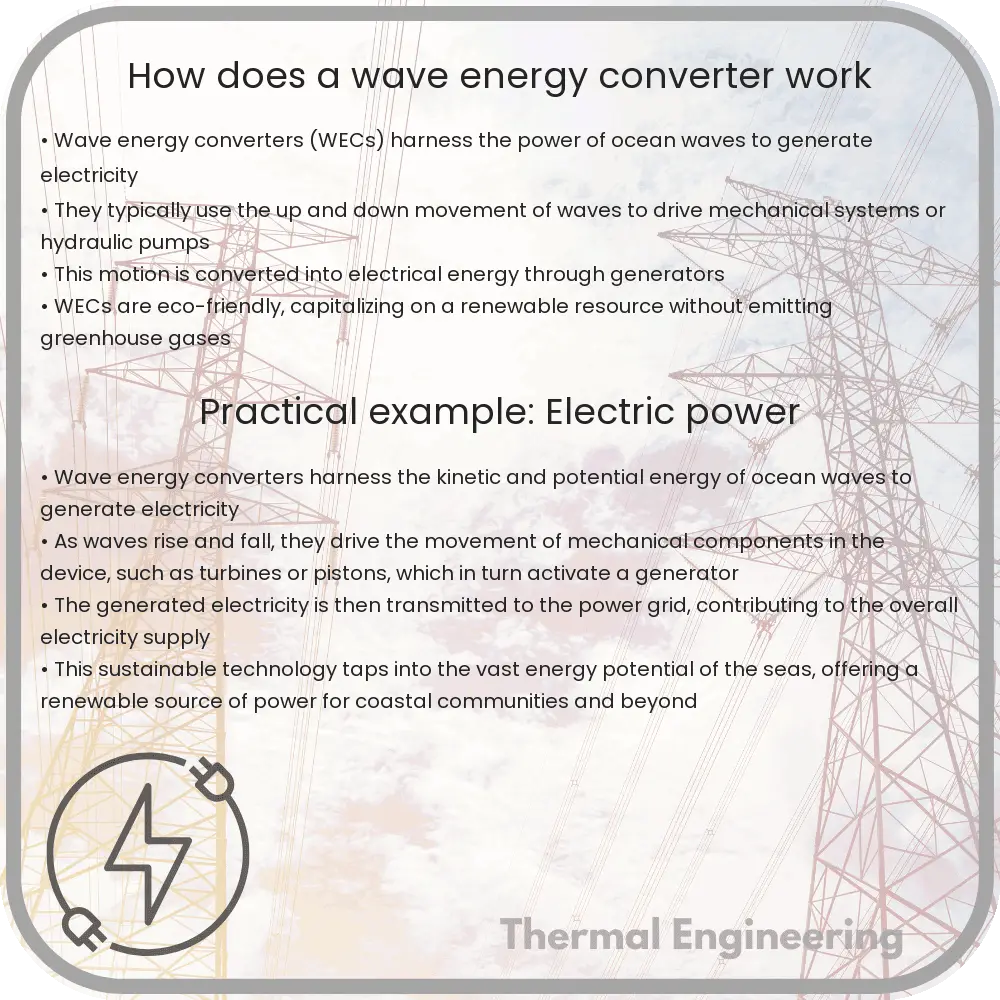Learn about wave energy converters (WECs), innovative devices that utilize ocean wave movements to generate clean, renewable electricity.

Understanding Wave Energy Converters
Wave energy converters (WECs) are fascinating devices designed to harness the power of ocean waves to generate electricity. This form of renewable energy is gaining attention due to its potential for providing a clean and sustainable alternative to fossil fuels. In this article, we’ll explore how wave energy converters work, their types, and their advantages and challenges.
Principles of Wave Energy Conversion
Wave energy converters operate on the basic principle of capturing the energy generated by the movement of surface waves or pressure fluctuations beneath the surface. The energy in waves comes from the wind as it blows across the sea surface. This movement and the energy transfer result in wave patterns, which can be harnessed and converted into useful energy.
There are several methods by which WECs capture and convert wave energy into electrical energy:
- Oscillating Water Columns (OWCs): These devices use the motion of rising and falling water levels within a column to drive air into and out of the top of the column, thereby turning a turbine connected to a generator.
- Point Absorbers: Typically floating structures that move with the waves, this motion is then used to drive hydraulic pumps or other mechanical converters attached to generators.
- Oscillating Body Converters: These converters involve floating or submerged bodies that oscillate in response to waves, and the motion is used to generate electricity.
- Attenuators: Long, multi-segmented floating structures oriented parallel to the wave direction, which flex at the joints where segments are connected. The relative motion at these joints is converted into electrical power via hydraulic systems and generators.
- Over topping Devices: These use a ramp to guide incoming waves into a reservoir; the water then returns to the sea through a turbine.
Key Components and Function
Common components of a wave energy converter include:
- Float or Buoy: Part that moves with the wave motion, capturing kinetic energy.
- Generator: Converts mechanical energy into electrical energy.
- Turbine: In devices like OWCs, a turbine is used for converting pneumatic power into mechanical power.
- Mooring System: Anchors the device to the sea floor and restricts motion to a specific range.
The efficiency of converting wave energy into electrical power depends on wave height, wavelength, wave speed, water density, and the design of the converter. The equation for wave power per unit length of wave crest can be expressed as:
P = (ρ * g2 * H2 * T) / (32π)
where:
- P is the power,
- ρ is the water density,
- g is the acceleration due to gravity,
- H is the wave height,
- T is the wave period.
Advantages and Challenges
The primary advantage of wave energy is that it is both renewable and environmentally friendly. Unlike fossil fuels, wave energy does not emit greenhouse gases. Furthermore, wave energy is relatively predictable and can provide a stable energy output under favorable conditions.
However, wave energy also faces several challenges. The overall cost of development and maintenance of WECs is still quite high compared to traditional energy sources. The marine environment is harsh, and WECs must withstand rough weather, corrosive saltwater, and biological fouling. Moreover, there are concerns related to the impact on marine ecosystems and navigation.
Conclusion
Wave energy converters represent an exciting frontier in renewable energy technology. Despite facing significant challenges, ongoing research and development could see these devices playing a crucial role in our future energy mix. As technology progresses and costs decrease, wave energy could become a more prominent player in global renewable energy strategies.